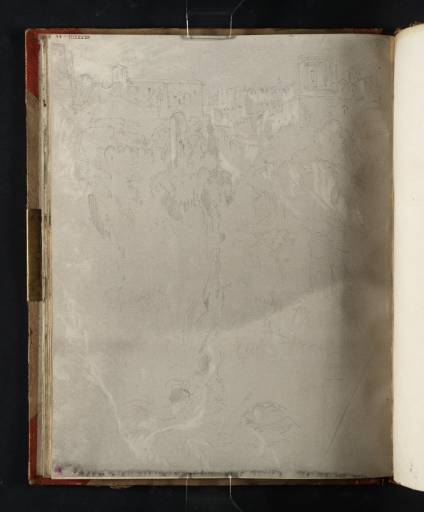Joseph Mallord William Turner View of Tivoli from the Valle d'Inferno, with the So-Called Temples of Vesta and the Sibyl 1819
Image 1 of 2
Joseph Mallord William Turner,
View of Tivoli from the Valle d'Inferno, with the So-Called Temples of Vesta and the Sibyl
1819
Joseph Mallord William Turner 1775–1851
Folio 44 Recto:
View of Tivoli from the Valle d’Inferno, with the So-Called Temples of Vesta and the Sibyl 1819
D15512
Turner Bequest CLXXXIII 44
Turner Bequest CLXXXIII 44
Pencil and grey watercolour wash on white wove paper, 253 x 200 mm
Inscribed by the artist in pencil ‘Yellow R’ and ‘Grey’ within centre of gorge
Inscribed by ?John Ruskin in faded red ink ‘44’ bottom left, inverted, and by an unknown hand in pencil ‘44’ bottom left, inverted
Stamped in black ‘CLXXXIII 44’ top left, inverted
Inscribed by the artist in pencil ‘Yellow R’ and ‘Grey’ within centre of gorge
Inscribed by ?John Ruskin in faded red ink ‘44’ bottom left, inverted, and by an unknown hand in pencil ‘44’ bottom left, inverted
Stamped in black ‘CLXXXIII 44’ top left, inverted
Accepted by the nation as part of the Turner Bequest 1856
References
1909
A.J. Finberg, A Complete Inventory of the Drawings of the Turner Bequest, London 1909, vol.I, p.541, as ‘Do. [Tivoli, with Temple of Sibyl on right]’.
1983
Cecilia Powell, ‘Turner’s Vignettes and the Making of Rogers’ “Italy” ’, Turner Studies, Summer 1983, vol.3, no.1, p.7.
1984
Cecilia Powell, ‘Turner on Classic Ground: His Visits to Central and Southern Italy and Related Paintings and Drawings’, unpublished Ph.D thesis, Courtauld Institute of Art, University of London 1984, p.285 note 70.
1987
Cecilia Powell, Turner in the South: Rome, Naples, Florence, New Haven and London 1987, p.[135] note 110.
The subject of this sketch is a view of Tivoli from the river valley to the north-east of the town. The view looks up the steep sides of the gorge to the famous temples of the Acropolis in the right-hand corner: on the left, the circular so-called Temple of Vesta; and on the right, the rectangular Temple of the Sibyl, which until the end of the nineteenth century was incorporated within the Church of San Giorgio. On the opposite side of the ravine is a jutting promontory with houses built right up to the edge (present-day Hotel Sirene), and in between the two sides, the former falling point the ‘Grand Cascade’ of the River Aniene. Turner’s viewpoint is from the floor of the Valle d’Inferno (Valley of Hell), the steep wooded gorge beneath the temples. Visible in the foreground is a cave known as the Grotto of Neptune. Related studies can be seen on folios 19 and 43 (D15485, and D15511), as well as in the Tivoli and Rome sketchbook (Tate D15074; Turner Bequest CLXXIX 77a), and in the Naples: Rome C. Studies sketchbook (Tate D16118 and D16146–D16147; Turner Bequest CLXXXVII 30 and 58–9). Like many drawings within this sketchbook, the composition has been executed over a washed grey background. Turner has created highlights within the work by rubbing or lifting out the wash to reveal the white paper beneath.
For over two hundred years, the vista of the ancient ruined temples seen above the gorge with the nearby cascades of the River Aniene had been one of the most frequently depicted prospects in Tivoli.1 Compare a contemporaneous drawing by James Hakewill (1778–1843), Temple of the Sibyl, Tivoli (British School at Rome Library).2 As Cecilia Powell has discussed, Turner later developed his sketches and memories of the site within a vignette illustration for Rogers’s Italy, published in 1830 (see Tate D27683; Turner Bequest CCLXXX 166).
Nicola Moorby
February 2010
See for example views by Gaspard Dughet, in Anne French, Gaspard Dughet, called Gaspar Poussin 1615–75, exhibition catalogue, Kenwood, London 1980, nos.20 and 23, reproduced, and Thomas Jones and Francis Towne, reproduced in Francis W. Hawcroft, Travels in Italy 1776–1782: Based on the Memoirs of Thomas Jones, exhibition catalogue, Whitworth Art Gallery, Manchester 1988, nos.50 and 53.
How to cite
Nicola Moorby, ‘View of Tivoli from the Valle d’Inferno, with the So-Called Temples of Vesta and the Sibyl 1819 by Joseph Mallord William Turner’, catalogue entry, February 2010, in David Blayney Brown (ed.), J.M.W. Turner: Sketchbooks, Drawings and Watercolours, Tate Research Publication, December 2012, https://www


